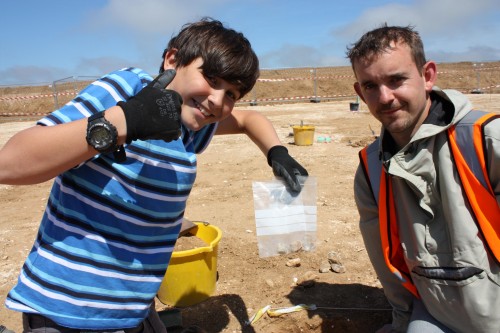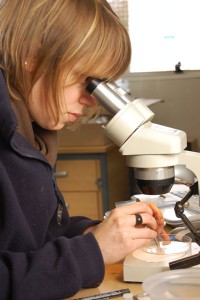There will be a chance to see some of the finds from the project and ask the experts questions at the Kent County Show at Detling, 16th-18th July 2010.
The display about the excavations forms part of Kent County Council’s exhibition at the Show.
There will be a chance to see some of the finds from the project and ask the experts questions at the Kent County Show at Detling, 16th-18th July 2010.
The display about the excavations forms part of Kent County Council’s exhibition at the Show.
Hundreds of people took time out to discover some of the secrets of east Kent’s past on Thanet’s big dig at the weekend.
Giving the thumbs up are 10-year-old Samuel Bordas, left, and his dad, Chris Smith, from Second Avenue, Cliftonville, who joined other volunteers working on the community excavation.

10-year-old Samuel Bordas, left, and his dad, Chris Smith, from Second Avenue, Cliftonville
Kent County Council principal archaeological officer Simon Mason said: “Everyone really enjoyed themselves. We were pleased that they had the chance to see their local heritage. I had lots of positive comments.”
The dig is the biggest in the country this year and has attracted more than 100 volunteers.
Another open day is planned in June before construction work begins in earnest on the East Kent Access road between Ramsgate and Sandwich.
During the investigation of an Anglo-Saxon cemetery near Manston along the East Kent Access Road, I had the opportunity to excavate a particularly interesting grave. This contained the remains of what appeared to be an elderly male, probably buried within a coffin. The grave, which was dug into the natural chalk, was unusually large, measuring 2.5 x 1.15 x 0.57m. The grave was aligned east to west which suggests that the man may have been a Christian.
Although the man’s bones were in poor condition, the objects he was buried with were exciting to uncover, both as an archaeologist and as an Anglo-Saxon re-enactor. This man had been buried with a scramasax, a type of short sword, across his chest. The scramasax was 15 inches (36cm) long. As well as this three smaller knives had been placed by his left side.
The word Scramasax is Anglo-Saxon and in those times they were not only practical weapons but also an indication of the social status of the individual. A free man would not travel anywhere without his scramasax attached to his belt across his waist, and it is likely that this man held an important role in the community– maybe a Shire Reeve.
Some metal objects from a belt were found at the dead man’s waist. There was a small copper buckle on his right side near his pelvis and a small copper belt fitting on his left side. By his feet there were also some iron objects. One of these had a small copper rivet through it and it might be from a sword scabbard?
This man was obviously important and well respected by his family to have such fine objects buried with him.
Michael Harris.
Thanet’s latest big dig revealing the area’s exciting history is being captured on film.
A rich vein of important archaeological remains discovered along the entire route of the East Kent Access road is being recorded for a major BBC2 documentary, Digging for Britain. The programme is due to be broadcast in August.
The excavation is the largest dig in the country in 2010 – over six kilometres long.
The finds include twelve Bronze Age ring ditches (the remains of burial mounds) dating back over 3,500 years, Iron Age enclosures and a village which lasted into Roman times at Ebbsfleet.
There are also areas of Roman settlements, their fields and track ways, Roman and Saxon cemeteries, Saxon buildings, and a large Saxon enclosure with huge quantities of shellfish, evidence of the preparation of a feast or processing later provisions.
More recent finds include the remains of trenches excavated to defend Manston airfield during the second world war.
Kent County Council principal archaeological officer Simon Mason, who was interviewed on location, said:
“Thanet was the gateway to England in ancient times and it’s no surprise that this dig has unearthed so many valuable remains. What is impressive is the story it tells us about how people were living here.”
Local people are being invited to get involved with the big dig. Volunteers can work alongside professional archaeologists during a community excavation from 10 May until 4 June, and school visits are being arranged. Archaeologists are also available to talk to schools, societies and local organisations.
The BBC have recently covered our work on the East Kent Access Road. The news feature “Thanet road dig uncovers 5,000 years of Kent history” is available to watch on the BBC News website.
Kent County Council say:
“Exciting archaeological discoveries are being made on Thanet this spring and local people are being asked to join the excavation and help.
Archaeologists are excavating and recording remains on the route of the East Kent Access Road on the Isle of Thanet in Kent. The excavation is the largest dig in the country in 2010: archaeologists will excavate an area over 6km in length before road works begin.
The new road is in an area particularly rich in archaeological remains from prehistoric, Roman and Saxon times. The road runs close to the mouth of the Wantsum Sea Channel, an important route that was a gateway for ancient peoples into Kent used by ships until medieval times. We think that a number of revolutionary events in British history took place in this area: the invading Roman Emperor Claudius landed at Richborough in AD43; the arrival of Saxons in the fifth century and later the landing of St Augustine with his mission to bring Christianity back to Britain in AD597.
Now the soil is removed important archaeological remains have been revealed all along the route. Among the important discoveries are: the remains of nine Bronze Age barrows (burial mounds) dating back over 3,500 years; numerous Iron Age enclosures and a village which lasted into Roman times at Ebbsfleet. There are also several areas of Roman settlement scattered across the landscape connected by tracks and roads, some of which are still in use today; Roman and Saxon cemeteries; Saxon buildings and a large Saxon enclosure with evidence of a huge shellfish feast. A medieval farmstead has been found close to Richborough Power Station.
The archaeological investigations are commissioned by Kent County Council through their road builders VolkerFitzpatrick Hochtief JV and are scheduled to continue into the summer.
A programme of talks and exhibitions will allow local people to see some of the archaeological remains as they are uncovered. Members of the public are encouraged to get involved by volunteering to help the archaeologists work on the artefacts and will have an opportunity to participate in a community excavation in one section of the route.
The East Kent Access Road will provide better road connections between the Isle of Thanet, the national motorway network, Kent International Airport, Canterbury and the European Gateways of Ramsgate, Dover and the Channel Tunnel with 8km of the A256 and A299 upgraded to dual carriageway.
The project is jointly funded by the Department of Transport (£81.25m) and Kent County Council (£5.75m) and should be complete in 2012.
The new road crosses one of the richest archaeological areas in Britain. Before the building starts, archaeologists will excavate along the whole length of the route. This will be the largest excavation in Britain in 2010, covering approximately 40 hectares.
Oxford Wessex Archaeology will carry out archaeological work on behalf of the company constructing the new road for Kent County Council, VolkerFitzpatrick Hochtief Joint Venture.
The archaeological work will be complete by mid-summer. Until then, there will be opportunities for the local community to visit the site and even help with the dig. For more information, please visit: https://eastkent.owarch.co.uk/
Exciting archaeological discoveries are being made on Thanet this spring and local people are being asked to join the excavation and help.
Archaeologists are excavating and recording remains on the route of the East Kent Access Road on the Isle of Thanet in Kent. The excavation is the largest dig in the country in 2010: archaeologists will excavate an area over 6km in length before road works begin.
The new road is in an area particularly rich in archaeological remains from prehistoric, Roman and Saxon times. The road runs close to the mouth of the Wantsum Sea Channel, an important route that was a gateway for ancient peoples into Kent used by ships until medieval times. We think that a number of revolutionary events in British history took place in this area: the invading Roman Emperor Claudius landed at Richborough in AD43; the arrival of Saxons in the fifth century and later the landing of St Augustine with his mission to bring Christianity back to Britain in AD597.
Now the soil is removed important archaeological remains have been revealed all along the route. Among the important discoveries are: the remains of nine Bronze Age barrows (burial mounds) dating back over 3,500 years; numerous Iron Age enclosures and a village which lasted into Roman times at Ebbsfleet. There are also several areas of Roman settlement scattered across the landscape connected by tracks and roads, some of which are still in use today; Roman and Saxon cemeteries; Saxon buildings and a large Saxon enclosure with evidence of a huge shellfish feast. A medieval farmstead has been found close to Richborough Power Station.
The archaeological investigations are commissioned by Kent County Council through their road builders VolkerFitzpatrick Hochtief JV and are scheduled to continue into the summer.
A programme of talks and exhibitions will allow local people to see some of the archaeological remains as they are uncovered. Members of the public are encouraged to get involved by volunteering to help the archaeologists work on the artefacts and will have an opportunity to participate in a community excavation in one section of the route. Further details are on www.eastkent.owarch.co.uk/.
——
The East Kent Access Road will provide better road connections between the Isle of Thanet, the national motorway network, Kent International Airport, Canterbury and the European Gateways of Ramsgate, Dover and the Channel Tunnel with 8km of the A256 and A299 upgraded to dual carriageway.
The project is jointly funded by the Department of Transport (£81.25m) and Kent County Council (£5.75m) and should be complete in 2012
The new road crosses one of the richest archaeological areas in Britain. Before the building starts, archaeologists will excavate along the whole length of the route. This will be the largest excavation in Britain in 2010, covering approximately 40 hectares.
Oxford Wessex Archaeology will carry out archaeological work on behalf of the company constructing the new road for Kent County Council, VolkerFitzpatrick Hochtief Joint Venture.
The archaeological work will be complete by mid-summer. Until then, there will be opportunities for the local community to visit the site and even help with the dig. For more information, please visit: https://eastkent.owarch.co.uk/”
On the weekend of 27th and 28th March, locals in Margate and Broadstairs will get the chance for a preview of the exciting discoveries archaeologists are making on the route of Kent County Council‘s new East Kent Access Road between Richborough and Manston.
An archaeology ‘Roadshow’ will be held at Margate Library on Saturday 27th March and outside Debenhams at the Westwood Cross Shopping Centre on Sunday 28th.
As well as range of family orientated activities, some of the finds unearthed so far will be on display and there will be a small exhibition. Archaeologist David Crawford-White, who is the archaeology Outreach Officer for the road scheme, will be on hand with the latest news.
On Sunday, Jennifer Jackson the Finds Liaison Officer of Kent County Council will also be there to identify unknown objects that people can bring along. Members of the Trust for Thanet Archaeology and the Powell-Cotton Museum will also be on hand with advice and information.
David Crawford-White, said ‘This is a great opportunity for local people to hear the latest news, to bring along those unknown objects and get them identified, meet local archaeologists and to see how they can get involved in archaeology.’
He added ‘We can also provide free talks to local groups and organisations as well as visits to schools and will be will running a community excavation later in the year.’
The road shows will be open between 09:00 and 16:30 each day.
For further details on the archaeology community programme and how to get involved visit our volunteers section.
Date: Saturday 27th March
Venue: Margate Library, Cecil Street, Margate
Time: 09.00 am-4.30 pm
Date: Sunday 28th March
Venue: Westwood Cross Shopping Centre
Time: 09.00 am-4.30 pm
Welcome to the website of the Archaeology of the East Kent Access Road.
We have been working on the site of the new road since October last year. To begin with, the route of the road was walked in a careful and systematic way and any finds (pottery, bone etc) visible on the surface of the ploughed fields were collected and recorded, test pits were hand excavated and local metal detectorists worked with the archaeological team to recover metal artefacts from the ploughsoil. All of the information gathered helped us to pinpoint the sites of ancient settlements buried beneath the ground.
Once these surveys had been completed, we began the process of carefully stripping off the topsoil with large earth-moving equipment. In the hands of a skilled operator, these machines remove topsoil extremely delicately, avoiding any damage to the archaeology beneath. We have now removed topsoil from an area of about 20 ha (the size of 20 football pitches) revealing the remains of Bronze Age barrows (burial mounds), Iron Age and Roman settlements and burials, and a medieval farmstead.
All of these remains are now being excavated by a team of around 90 Oxford Wessex Archaeology (OWA) archaeologists, working in all weather conditions. All of this work produces large quantities of written and drawn records and photographs along with bags and bags of finds (including pottery, bone and ancient building materials) and samples of soil from buried pits and ditches. All of this material is taken to the main site compound where the records are digitised and entered into our databases.

Once soil samples have been processed, the residues are sorted under a microscope to recover seeds, small animal bones and other remains.
At the compound, the finds are carefully washed and studied. Soil samples are processed and sifted through to recover seeds, grain and small animal bones, all of which help us to build up a picture of how and where are ancestors lived, what the environment was like and how it has changed over time. In other words, it helps us to write the history of the people who have lived, worked and died on Thanet through the ages.
This is an incredibly exciting project to work on and I hope that many of you will take the opportunity to come and work with us. There are a number of ways in which people can volunteer on the site, details of which can be found in the outreach section of this website.
If volunteering is not for you, we will also be giving talks and guided tours to local schools and other groups and will be organising a number of Open Days later in the year. And, of course, we will be updating this website with photos and reports from site as the excavation progresses.
Read more about the background to the project.


A new road is to be built on the Isle of Thanet in east Kent during 2010-11. The road will be 6.5 km long and will cross one of the richest archaeological areas in Britain.
Before the building starts archaeologists will excavate the whole length of the route. This will be the largest excavation in Britain in 2010, covering approximately 40 hectares.
Find out more about the East Kent Access Road.
Oxford Wessex Archaeology is a Joint Venture of Oxford Archaeology and Wessex Archaeology, the two largest archaeological organisations in the UK.